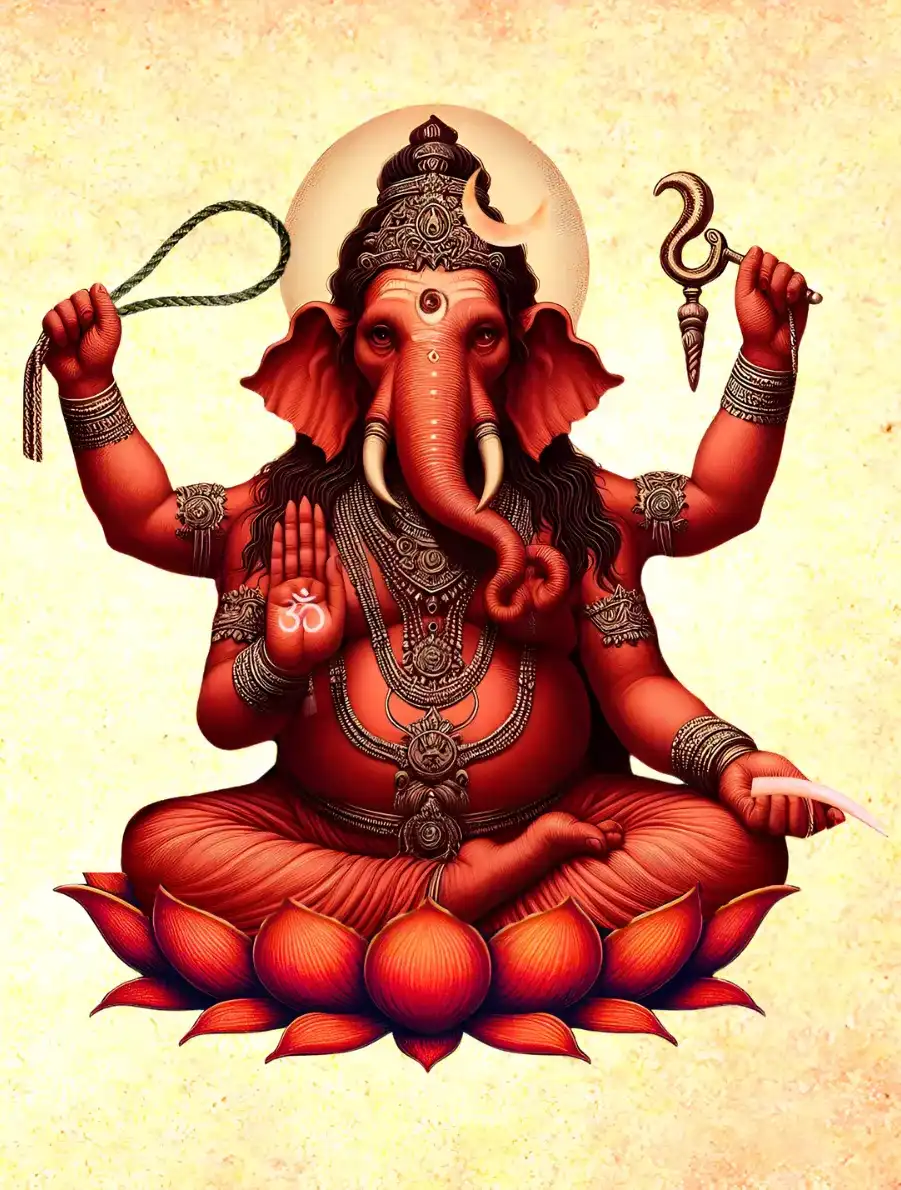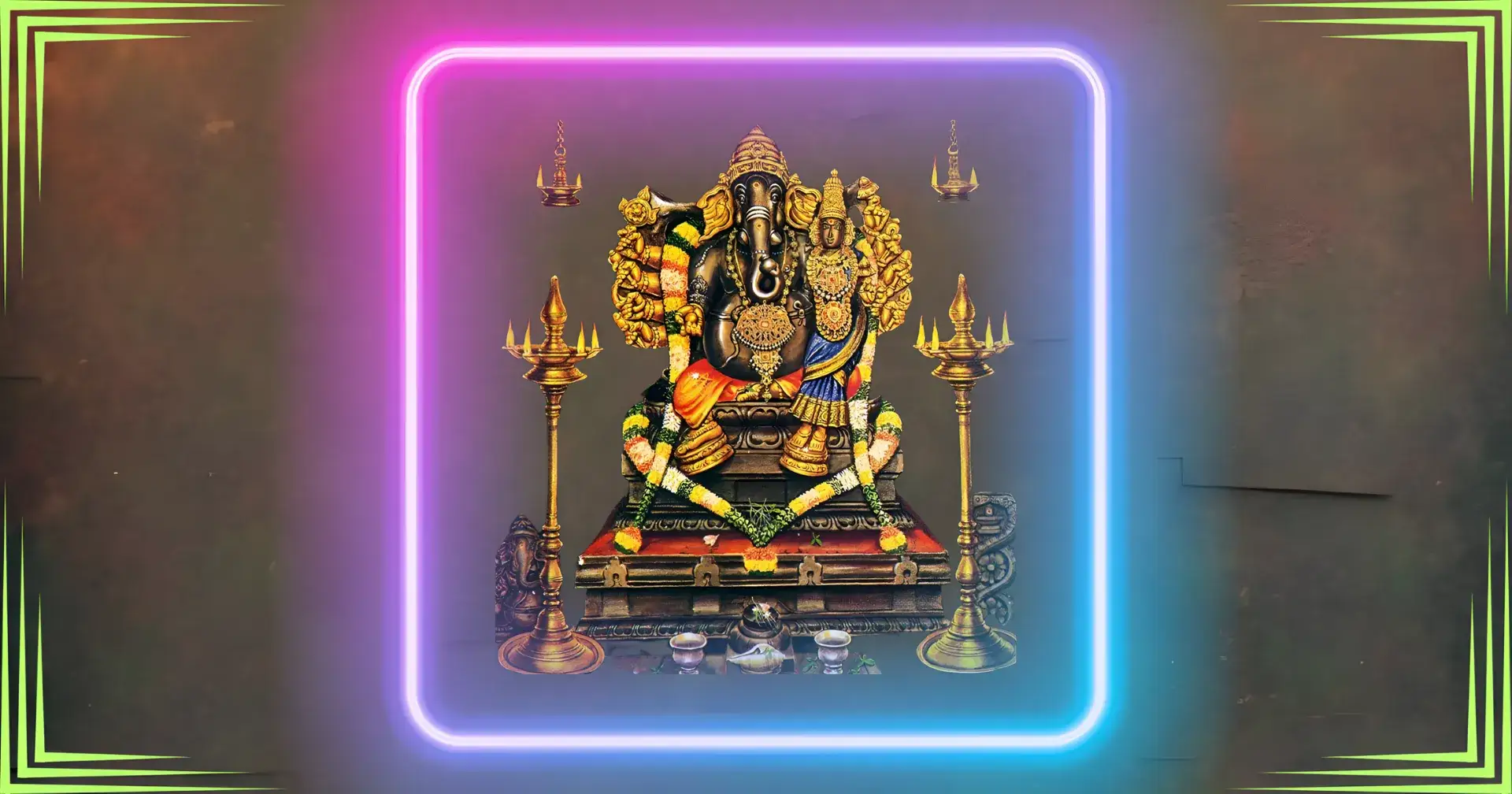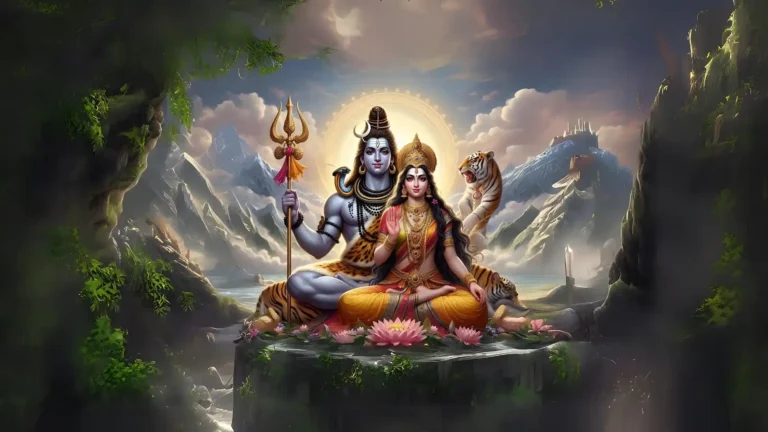Please Like the Blog and Share it for Maximum Reach
Table of Contents
7 Secret Highlights of the Ucchistha Ganapati Tantra
The invocation of Ucchistha Ganapati with Pishachi for fulfilling desires.
Importance of the Navarna and Daśākṣari mantras.
The role of a Guru in safe Tantra practices.
Caution against desire-driven practices in Tantra.
Advantages of Sattvik forms of worship.
The dangers of misuse in Abhicharas.Ganesha’s guidance toward Moksha over material gain.
Invocation of Pisachi Ganapati
In a Tantra text on the Upasana of the deity , the following verse appears:
श्रीमहादेव उवाच ॥
हस्तिपदं समुच्चार्य पिशाचीतिपदं ततः ॥
देवराजं सनेत्रं च कान्तमीशस्वरान्वितम् ॥
वह्निजायावधिमन्त्र स्ताराद्यः सर्वकामदः ॥
śrīmahādeva uvāca ||
hastipadaṃ samuccārya piśācītipadaṃ tataḥ ||
devarājaṃ sanetraṃ ca kāntamīśasvarānvitam ||
vahnijāyāvadhimantra stārādyaḥ sarvakāmadaḥ ||
This means:
Lord Shiva Says: By uttering the name of the Elephant as meant by the word Hasti, one then invokes the Pisachi. Now, Pisachis have many connotations. They are a manifestation of Shakti that interact with lower strata of consciousness.
The term vahni (वह्नि) suggests that the Pishachi accompanying Sri Hasti (Ganesha) is a Mahamatra. According to Kubjikamata Tantra, ‘Vahni’ is the 4th Mahamatra and is represented by fire.
This form of Ganapathy has been described to have heavenly eyes and is all auspicious. Those who dedicate themselves to Him will find fulfillment in all their desires.
Tantrik Form of Sri Ucchistha Ganapati
In the Tantra Text of Ucchistaganapti and Ucchisthachandalini Upasana it is mentioned
ॐशरान्धनुः पाशसृणी स्वह स्तैर्दधानमारक्तसरोरुहस्थम् ॥
विवस्त्रपत्न्यां सुरतप्रवृत्तमुच्छिष्टमम्बासुतमाश्रयेऽहम् ॥ १ ॥
oṃ śarāndhanuḥ pāśasṛṇī svaha stairdadhānamāraktasaroruhastham ||
vivastrapatnyāṃ suratapravṛttamucchiṣṭamambāsutamāśraye’ham || 1 ||
This verse briefly describes the form of Sri Ucchistha Ganapathi.

I take refuge under Sri Ucchista Ganapati (the son of Devi Amba) who wields a quiver-bow, a noose, a sickle and is adorned with paddy. He is situated in a red-lotus, engaged in amorous pastime with his unclad consort.
Sri Ucchista Ganapati Navarna mantra
Each mantra is interpreted differently, by different gurus, sampradayas and practicing sadhakas. This is because the mantra is a repository of all knowledge. It houses both the known and the unknown. The process of initiation is the transmission of the import of the mantra that was revealed in the heart of the Guru. Thus, though the mantra is one, the meanings can be several.
The 655th name of Lord Ganesha in Ganesha Sahasranamavali is: ॐ हस्तिपिशाचीशाय नमः। It means Salutations to the Lord of Pishachas. Thus, here Hasti directly refers to Lord Ganesha.
The Navarna mantra of Sri Ucchista Ganapati goes like this- हस्ति पिशाचि लिखे स्वाहा . It means I invoke the powerful energies of the elephant (Lord Ganesha) and the Pisachi in the void (or secluded space, such as the cremation ground); I offer this reverently..
Hasti (ganapati) is accompanied by a Pishachi. The inclusion of खे in the Navarna mantra alludes to a cremation ground, as खे in Sanskrit means void or empty.
In Tantra seclusion or emptiness is directly associated with Cremation grounds. The ambience is pristine, devoid of any fluctuations caused by human intervention as it is engulfed by the vibration of the dead. The predominance of emptiness in such places is conducive for the fructification of many Vamachara Sadhanas.
Though Pishachis are born from celestial beings, they are closely associated with lower realms and vibrations. Due to this affinity, it is believed that a perfected ritual propitiating the Tantrika deity can also manifest negative events, directed towards a higher cause.
A person following the rules and regulations, under a siddha tantra guru acquires mastery over Abhicharas. The Abhicharas vary in name and number, from one Tantrik text to another. Some of them are:
मारण (Causing Death), स्तंभन (Causing Hindrance), विद्वेषण (Creating Discord), उच्चाट्टन (Driving Away Ghosts, other Lowly Creatures, Negative People, or vibrations) and वशीकरण (Controlling the mind of others to accomplish goals). Pishachis are believed to possess hidden knowledge of realms and beings unknown to man. Many invoke the deity with this intent while certain others seek protection.

Some interpret Pishachis as lower creatures that cause havoc in marital life. They are perceived as beings with immense power. When called alone, she can cause disharmony in the life of the invoker. But, due to the presence of Ganesha, the lord of the Pishachas, all the unpleasant qualities are curbed. The negative energy, which is extremely powerful, is converted by Lord Ganesha to generate suitable outcomes for the reciter.
Sri Ucchista Ganapati Daśākṣari Mantra
The Dashakshari Mantra of Sri Ucchistha Ganapati is highly confidential due to the presence of the Pranava mantra (ॐ). In some traditions, the Pranava is substituted with the beej of Sri Ganesha gam (गं).
This beej is masculine in nature. It encapsulates the entire potency of Lord Ganesha. गं is the subtle manifestation of His very self, in the form of a sound vibration. Sri Ucchista Ganapati Daśākṣari Mantra, according to the Brihat Tantra Sara, is the essence of all mantras.
Several Tantra texts advise avoiding the widespread propagation of this mantra but have revealed it for the welfare of mankind alone. 16,000 repetitions completes the Purascharana cycle.

However, to unlock its power, the Mantra Deeksha process becomes mandatory. There are other supplementary conditions like observing the Tithi, specific offerings, presence of a Female Sadhaka, Vipra/Dwija (Brahmin) and guru during the Mantra Sadhana, etc. The process of the sadhana shall vary depending on the intrinsic nature of the sadhaka, after being examined by the guru.
7/8 Questions from Sanatana Dharma
The scores generated in this Quiz may or may not be absolute. There may be right or wrong answers to each Question. A percentage towards 100 indicates that you are more aligned to the overall subject matter.
Why is Tantra not Advisable?
Lord Ganesha has 32 forms and each form has a highlight. When propitiating a deity, especially a Tantrik deity, a sadhaka must be cognizant of the benefits and repercussions of the sadhana one undertakes.
Deities have multiple manifestations, accentuating a particular type of energy. When we take up sadhana of a particular deity, we are inviting the predominant vibration, the deity posessess, into our lives. Thus, it becomes essential to be aware of the characteristics and peculiarities of the Mantra Devata.
There is a great pitfall in the heterodoxical path. When a tantrik misuses the tantra bala, to harm others or for selfish interests, he suffers great consequences. A sadhaka employing tantrika rituals, with malintentions accrue insurmountable sin.
The Kularnava Tantra enlightens the curious but indecisive aspirants about the nature of Tantra: “You may walk on the sharp edge of a sword ; you may hold to the neck of a tiger; you may wear a serpent on the body ; but to follow a right the way of the Kula (a Shiva-Shakti Tantrik Tradition) is much more difficult.”
It is said that the gates of hell are left ajar the moment a practitioner slips from this path. Fundamentally, the popular notion of Tantra to gain material benefits is the root cause of one’s downfall. Indulging in the abhicharas (6 Black rites) calls for Prayaschita (repentance).

Tantrik Siddhis are not supposed to be exercised until circumstances demand them. Tantra should be performed for the welfare of mankind. For example: If a person is tormented by an evil spirit, a Tantrik can perform Ucchatan Karma and other auxiliary rituals. The intention should be genuine or else it shall accumulate negative karma for the Tantrik.
Advantage of Sattvik Forms of Worship
There is an inevitable role of the guru in Tantra, as there are many rules, regulations and nuances that one needs to consider and abide by. Usually, sadhakas invoking Sri Ucchista Ganapathi desire immense wealth, attractive women, success, victory over enemies, creating discord, etc.

The absence of spiritual yearning makes it extremely dangerous for people to venture into this dark and unknown path. Every wrong action has a negative outcome. But, if a person relinquishes material desires and only pursues spiritual goals, the sadhaka shall automatically be directed (by Nature) to deities who allow a more permissive form of worship.
However, when seeking material favors from the Lord, there are stringent rules and the slightest violation of these rules shall cause disastrous outcomes. For this reason Tantrik texts come with a caution for aspirants who seek as well as the gurus who guide others.
There is an extensive list of qualities that a practitioner must possess. Based on the intrinsic quality of the sadhaka, practices are prescribed by the guru.
In Tantra not everybody is eligible to perform certain rituals as it is a science that involves matter to appease the Lord. However, the path of Bhakti and Sattvik Sadhana is safe and open to all. In this path, methodology of performing rituals are secondary and it is purity of intention and devotion that is of paramount importance.

The Grace of the Guru accelerates one’s spiritual journey and shields the disciple from all malefic energies. There is no downfall if the sadhaka clasps onto Guru and Bhagawan. The Lord is easily pleased when a shishya adheres to the guru and performs devotional practices. Thus, adopting to Sattvik Sadhana becomes a more viable option to express one’s love for the deity.
Fulfillment of Desire- A Fallacy
The Vishnu Purana states:
न जातु काम: कामानामुपभोगेन शाम्यति |
हविषा कॄष्ण्मत्र्मेव भुय एवाभिवर्धते ||
Fulfillment of Desire is a fallacy. Just like how Ghee (clarified butter) aggravates the flames of fire, the indulgence in desire only increases its craving.
Srimad Bhagawatham (S.B. 9.9.14) has a similar viewpoint.
It means that the intent to fulfill desire shall endlessly invite dissatisfaction, an evolute of sorrow into our lives. The wise never take up sadhana with this intent. Ucchistha Ganapathy, out of utter graciousness grants wish fulfillment. However, Lord Ganesha reveals in the Ganesha Purana:
श्रीगजानन उवाच –
ईदृशं विद्धि मे तत्त्वं मद्गतेनान्तरात्मना ।
यज्ज्ञात्वा मामसन्दिग्धं वेत्सि मोक्ष्यसि सर्वगम् ॥ १ ॥
Lord Ganesha reveals His infinite attributes and elements. He is the very embodiment of Truth. When a sadhaka becomes cognizant of this eternal form of Lord Ganesha, He shall certainly attain Moksha.

Thus, a devotee of Lord Ganesha, while doing Upasana should aim for Moksha Prapti rather than mere Icchapoorti.
Please Like the Blog and Share it for Maximum Reach







